Sushi Sonagi
1425 Artesia Blvd, Gardena, CA 90248
www.instagram.com/sushi.sonagi/
Sat 12/16/2023, 05:30p-07:40p
The last time I reported on Daniel Son was back in September last year, when I checked out Katsu Sando in Chinatown. His sandwich shop grew to a second location in San Gabriel in March, but I was far more curious about his planned sushi spot, meant to expand on the omakase dinners he was serving back in the day over at Kura in WeHo, which shuttered in November 2019. My questions were answered earlier this year, when it was announced that Son would be opening Sushi Sonagi in the former strip mall home of the longstanding Kanpachi in Gardena. The restaurant ended up debuting at the start of July serving the Chef's unique style of Korean-inflected sushi omakase. And if you're wondering about the name, it's a reference to the Korean term 소나기, which denotes a period of heavy rain that stops suddenly.
![Sushi Sonagi Menu]()
![Sushi Sonagi Sake List]()
![Sushi Sonagi Sake & Beverage List]()
Sonagi's omakase is priced at $200 per person (up from $175 when the place first opened), with a $100 deposit required via Tock, and diners receive a printed copy of the menu, which is something that I wish more sushi restaurants would implement. Beverage-wise, there's a respectable selection of sake, but not much else, so you may want to make use of the corkage option, which is $45 a pop. Click for larger versions.
![Sushi Sonagi Bar]()
Pictured above is the view from my position at the sushi counter's rightmost seat; there is no table seating here. Do also note that the lower portion of the bar is actually a holdover from the Kanpachi days, as are all those wooden slats.
![Sushi Sonagi Place Setting]()
Here we see the place setting, replete with a warm oshibori.
![Chawanmushi, Ikura Shoyuzuke, SB Uni, Gamtae (Lidded)]()
![Chawanmushi, Ikura Shoyuzuke, SB Uni, Gamtae]()
1: Chawanmushi, Ikura Shoyuzuke, SB Uni, Gamtae
Son started us off with a substantial egg custard, paired with an even more substantial tongue of Santa Barbara sea urchin as well as the smoky savor of soy-marinated salmon roe. My favorite ingredient here, though, was that gamtae, with its wonderfully grassy, earthy, bitter notes that accented the egg beautifully. I'd actually like to see more chefs incorporate the seaweed into their chawanmushis.
![2006 Henri Goutorbe Champagne Grand Cru Special Club]()
One of my fellow diners graciously shared a pour of his 2006 Henri Goutorbe Champagne Grand Cru Special Club with us. The wine showed off a rich, concentrated nose filled with stone fruits and toast, while the palate demonstrated loads of depth, with a bevy of nutty, caramel-like notes joined by orchard fruits and minerals.
![Hokkaido Ankimo Tart, Astrea Kaluga Caviar]()
2: Hokkaido Ankimo Tart, Astrea Kaluga Caviar
A decidedly untraditional presentation of sake-poached ankimo effectively paired the monkfish liver's creamy, refined brine with the nutty salinity of caviar and a dusting of shiso blossom and chrysanthemum, all while the tart shell offered up contrast in both taste and texture.
![Wagyu Yukhoe Toast, Korean Pear, Kinome]()
3: Wagyu Yukhoe Toast, Korean Pear, Kinome
Son's take on beef tartare was a winner. I loved the nuttiness imparted by the sesame oil and how that enveloped the meat in such a familiar, satisfying manner. At the same time, the bae gave the bite a juicy sweetness, while the bread served as a moderating force.
![Sushi Geta + Gari]()
Here we see the somewhat unconventional sushi plate, as well as a portion of the Chef's excellent homemade ginger, which I found milder than most, with a great texture.
![Finger Napkin]()
Given that I typically eat sushi sans chopsticks, the arrival of a finger napkin was a welcomed nicety.
![2007 Vincent Dauvissat Chablis Grand Cru Les Preuses]()
We brought three bottles tonight, and the first was the 2007 Vincent Dauvissat Chablis Grand Cru Les Preuses. Initial aromas here highlighted sour fruits alongside barnyard and caramel. On the palate, I found the wine uncommonly silky, with loads of yellow fruit and a marked grassiness. With more time, the nose actually became more muted, and slightly saline, while taste-wise, I got a lot more saline, but with plenty of mature citrus and hints of pepper.
![Onagadai / Long-Tailed Snapper – Kagoshima]()
4: Onagadai / Long-Tailed Snapper – Kagoshima
I believe that this was my first time having onaga sushi, and hopefully it's not my last. The snapper was super soft to the bite, and demonstrated a sweetness that linked up superbly with the herby blossoms and the lingering burn of wasabi.
![Buri / Wild Yellowtail – Toyama]()
5: Buri / Wild Yellowtail – Toyama
Yellowtail arrived deeply savory, with a great wasabi-fueled heat, while the rice was particularly nutty, and did a great job mixing things up texturally as well.
![Shima Aji / Striped Jack – Kagoshima]()
6: Shima Aji / Striped Jack – Kagoshima
The striped jack had this wonderfully "crunchy" consistency, while its considerable umami notes once again juxtaposed swimmingly with Son's seemingly extra flavorful shari.
![Sawara / King Mackerel – Mie]()
7: Sawara / King Mackerel – Mie
The Spanish mackerel showcased a fantastic smoke that worked hand-in-hand with the fish's soft, fatty flesh, and I loved how the finish was redolent of both wasabi heat and umami.
![Sumagatsuo / Striped Skipjack Tuna – Kagoshima]()
8: Sumagatsuo / Striped Skipjack Tuna – Kagoshima
Not surprisingly, soy-marinated skipjack ate super savory, but its intensity was evened out by the rice, which was much milder in this bite, so I'm assuming that the Chef utilizes a couple different varieties depending on the neta.
![2020 Kokuryu 'Nizaemon' Junmai Daiginjo]()
Our second bottle was the 2020 Kokuryu "Nizaemon" Junmai Daiginjo (黒龍 ⼆左衛⾨), a 35% seimai-buai, Yamada Nishiki-based sake. The bouquet here was sugary and inviting, giving up loads of bubblegum and bananas, perked up by a tinge of peppery spice. Taking a sip, I found the nihonshu thick and viscous, its sweet, ricey flavors supported by a rotating cast of tropical fruits.
![Kohada / Gizzard Shad – Kumamoto]()
9: Kohada / Gizzard Shad – Kumamoto
Gizzard shad had that oceany taste you expect, but supported by an underlying fruitiness. The fish's strong flavors were balanced out by the very neutral rice utilized, as well as the sting of wasabi.
![Mehikari Tempura / Twinkly Eyes – Shizuoka]()
10: Mehikari Tempura / Twinkly Eyes – Shizuoka
Fried greeneye showcased a delectable brininess and a spot-on texture to boot, and matched flawlessly with that flaked salt. Given his apparent facility with tempura, I suggested to the Chef that he should open a tempura-ya next!
![Akagai / Ark Shell – Aomori]()
11: Akagai / Ark Shell – Aomori
Ark clam is a relatively rare sight at sushi-ya around Southern California, so I was happy to see it on the menu tonight. I loved its snappy, satisfying consistency, and its unabashedly oceany flavors matched swimmingly with the wasabi and a bit of mintiness, while the assertively-seasoned rice also served as a welcomed counterpoint.
![Ganjang Gejang Maki / Soy Cured Crab Roll – Korea]()
12: Ganjang Gejang Maki / Soy Cured Crab Roll – Korea
Two-week-fermented gejang was combined with Santa Barbara uni, shiso, and perilla oil, making for a creamy, sweet, saline mélange of flavors offset by the refreshing nature of shiso. My quibble here was that I wanted the seaweed to be crisper.
![Chef Daniel Son with Uni]()
![Uni / Sea Urchin – Hokkaido]()
13: Uni / Sea Urchin – Hokkaido
Hokkaido uni ate cool and creamy and utterly classic, with a mineral-driven quality that meshed seamlessly with the seaweed.
![2020 Kokuryu 'Hachijyuhachigo' Daiginjo]()
Our third and final bottle was the 2020 Kokuryu "Hachijyuhachigo" Daiginjo (黒龍 ⼋⼗⼋号), which also boasted the use of Yamada Nishiki and a 35% rice polishing ratio. Again, the sake smelled quite distinctly of fresh bananas, but with traces of herbs and spices. It was super smooth over the tongue, with its ricey, astringent, savory nuances joined by more spices as well as florals.
![Anago / Sea Eel – Nagasaki]()
14: Anago / Sea Eel – Nagasaki
Conger eel was melt-in-your-mouth tender, and just might've been the softest example I've ever had. It was also sweeter than usual, which worked with the fish's palpable smokiness.
![Dolsot Sekogani / Female Snow Crab – Fukui]()
![Chef Daniel Son Mixing Rice]()
![Dolsot Sekogani / Female Snow Crab – Fukui (In Bowl)]()
15: Dolsot Sekogani / Female Snow Crab – Fukui
The seikogani, served with its roe and kanimiso, was definitely a favorite, and easily a contender for the best thing I've eaten all year. I just got loads of concentration, depth, brine, umami, and sheer crab-y goodness, and reveled in all that nutty, crispy, toasty nurungji. Everything just came together flawlessly.
![Dungeness Crab Soup, Shingiku, Yuzu – Oregon (Lidded)]()
![Dungeness Crab Soup, Shingiku, Yuzu – Oregon]()
16: Dungeness Crab Soup, Shingiku, Yuzu – Oregon
Cabbage-wrapped Dungeness displayed some wonderfully homey, yet delicate flavors, boosted by a mushroom dashi, while the shungiku brightened things up.
![Miso Butter Atsuyaki Tamago / Miso Butter Omelet]()
17: Miso Butter Atsuyaki Tamago / Miso Butter Omelet
Son's tamagoyaki incorporates miso, butter, scallop, and shrimp, and was quite a bit more assertive (and tastier) than most. Think sweet and saline, and quite "juicy."
![Yuzu Panna Cotta, Mandarin Ice – Torrance]()
18: Yuzu Panna Cotta, Mandarin Ice – Torrance
A zippy citrus granita was set against yuzu pudding, making for a palate-cleansing sort of dessert that left me refreshed.
![Sushi Sonagi Thank You Card (In Envelope)]()
![Sushi Sonagi Thank You Card]()
We were given a thank you card at the end of the meal, which was a nice detail. If you're curious about Janet and Annie, they're the Chef's wife and sister, respectively, who help with running the restaurant.
Sushi Sonagi made a strong case for itself tonight, and in fact, I'd deem it one of my top meals in LA this year. Son clearly respects Japanese tradition, but at the same time, he's clearly not bound by it. I really enjoyed the thoughtful Korean touches that he incorporated into the meal, and also appreciated the Chef's affability and the family-run nature of the restaurant. It all came together for an omakase experience unlike any other in the region, and I have to conclude that Sonagi is a worthy addition to Los Angeles' sushi pantheon.
![Volcano Burgers]()
We weren't quite stuffed after dinner, so for some final bites, we made our way to Volcano Burgers in Los Alamitos, an old haunt of mine from my teenage years.
![Chili Cheese Fries + Onions]()
Chili Cheese Fries + Onions [$7.99]
The dish to get is the chili fries, which I first tried in 1995 and which I still order every single time I come here. The fries they use are the perfect type for this application, and I can't fault the chili either, while the zestiness of those onions is absolutely crucial, really brightening things up. I have yet to find a better chilli fries.
1425 Artesia Blvd, Gardena, CA 90248
www.instagram.com/sushi.sonagi/
Sat 12/16/2023, 05:30p-07:40p
The last time I reported on Daniel Son was back in September last year, when I checked out Katsu Sando in Chinatown. His sandwich shop grew to a second location in San Gabriel in March, but I was far more curious about his planned sushi spot, meant to expand on the omakase dinners he was serving back in the day over at Kura in WeHo, which shuttered in November 2019. My questions were answered earlier this year, when it was announced that Son would be opening Sushi Sonagi in the former strip mall home of the longstanding Kanpachi in Gardena. The restaurant ended up debuting at the start of July serving the Chef's unique style of Korean-inflected sushi omakase. And if you're wondering about the name, it's a reference to the Korean term 소나기, which denotes a period of heavy rain that stops suddenly.
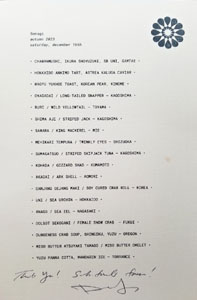
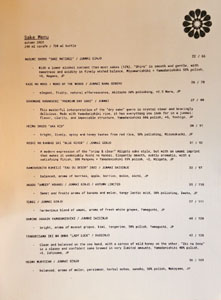
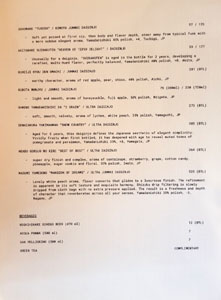
Sonagi's omakase is priced at $200 per person (up from $175 when the place first opened), with a $100 deposit required via Tock, and diners receive a printed copy of the menu, which is something that I wish more sushi restaurants would implement. Beverage-wise, there's a respectable selection of sake, but not much else, so you may want to make use of the corkage option, which is $45 a pop. Click for larger versions.
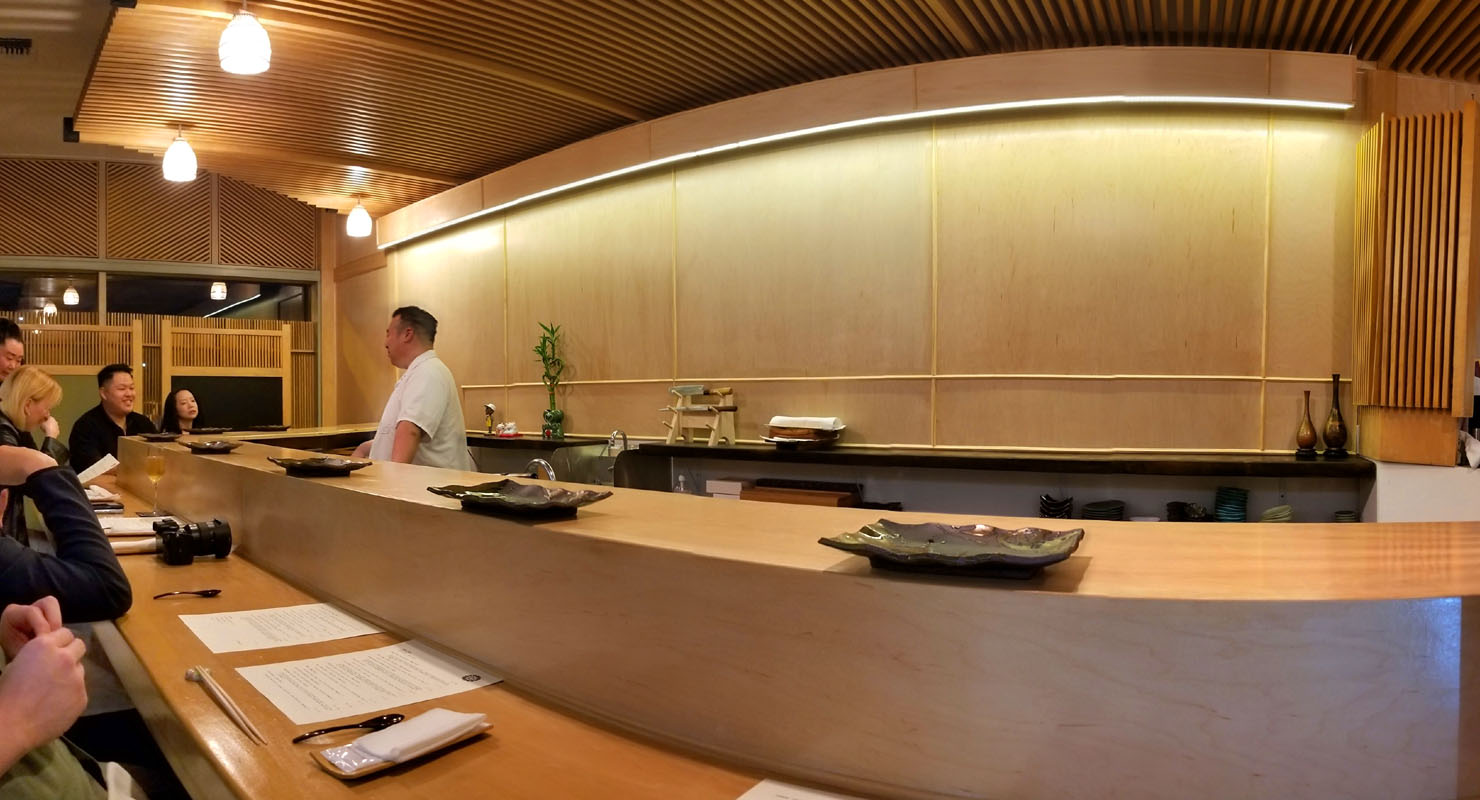
Pictured above is the view from my position at the sushi counter's rightmost seat; there is no table seating here. Do also note that the lower portion of the bar is actually a holdover from the Kanpachi days, as are all those wooden slats.
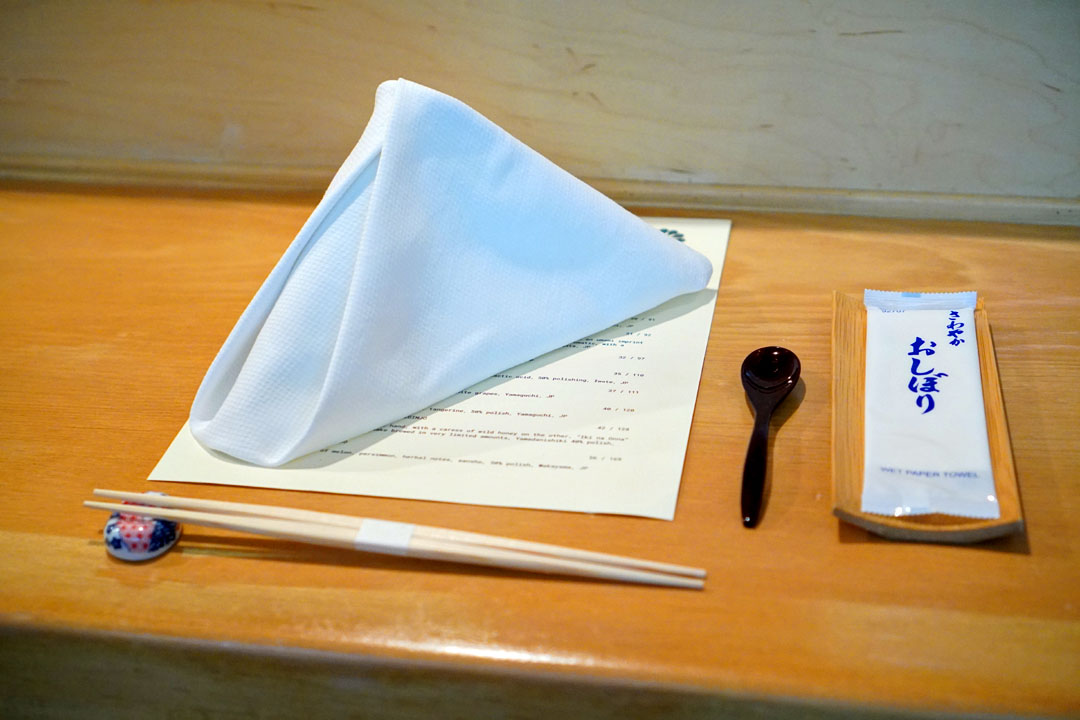
Here we see the place setting, replete with a warm oshibori.
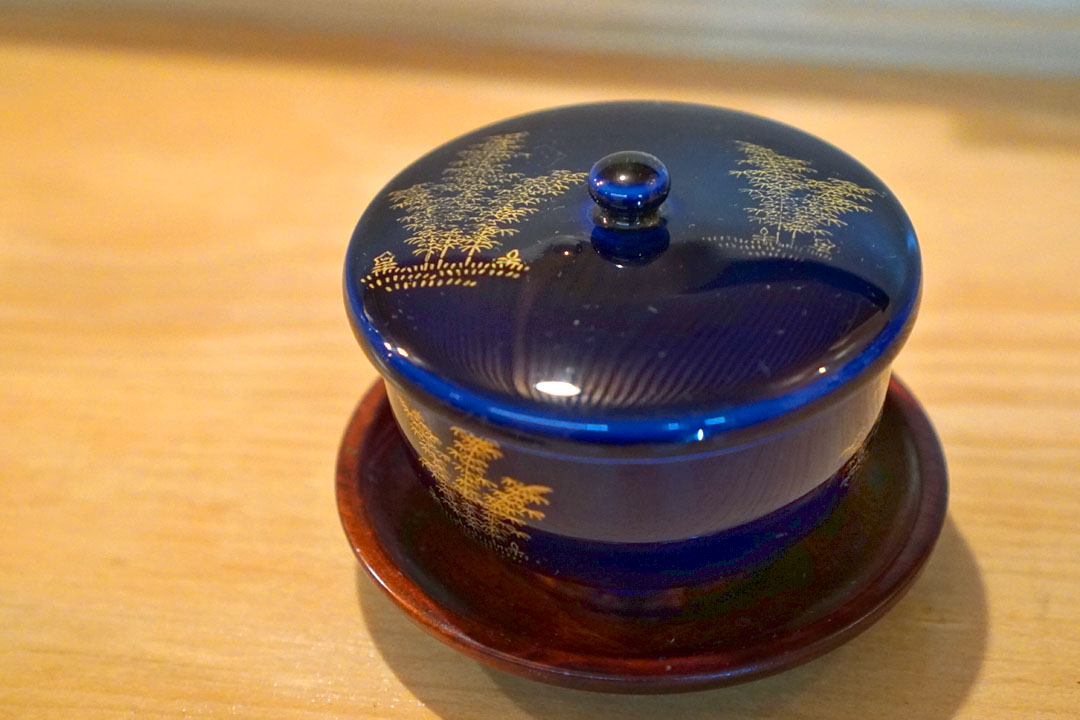

1: Chawanmushi, Ikura Shoyuzuke, SB Uni, Gamtae
Son started us off with a substantial egg custard, paired with an even more substantial tongue of Santa Barbara sea urchin as well as the smoky savor of soy-marinated salmon roe. My favorite ingredient here, though, was that gamtae, with its wonderfully grassy, earthy, bitter notes that accented the egg beautifully. I'd actually like to see more chefs incorporate the seaweed into their chawanmushis.
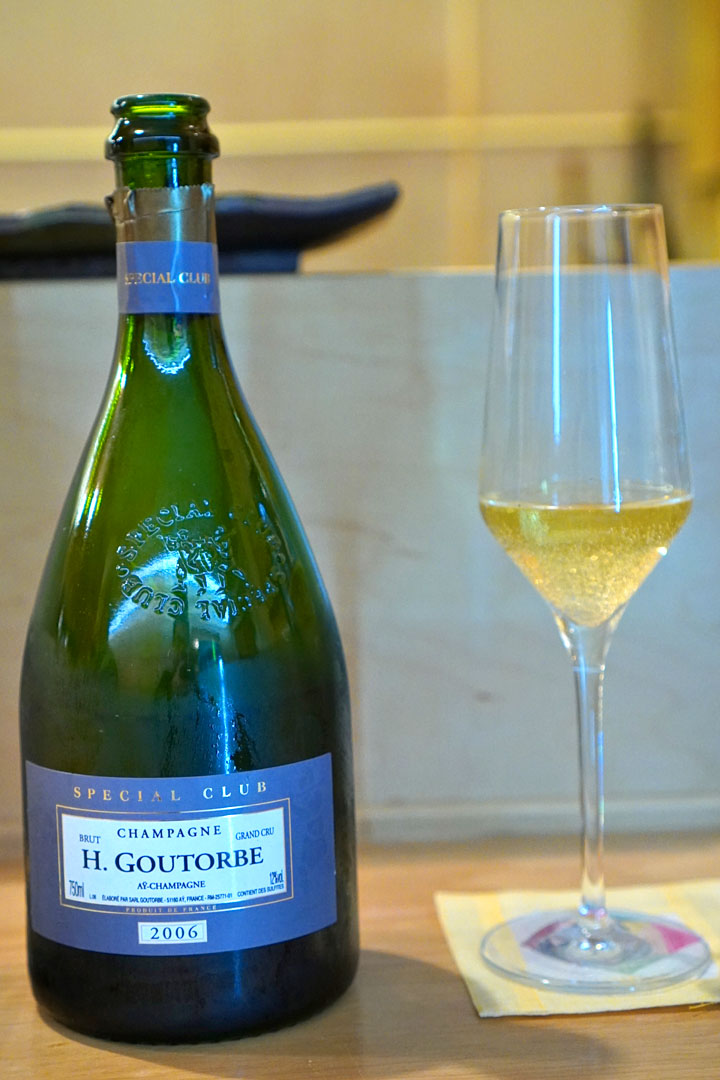
One of my fellow diners graciously shared a pour of his 2006 Henri Goutorbe Champagne Grand Cru Special Club with us. The wine showed off a rich, concentrated nose filled with stone fruits and toast, while the palate demonstrated loads of depth, with a bevy of nutty, caramel-like notes joined by orchard fruits and minerals.
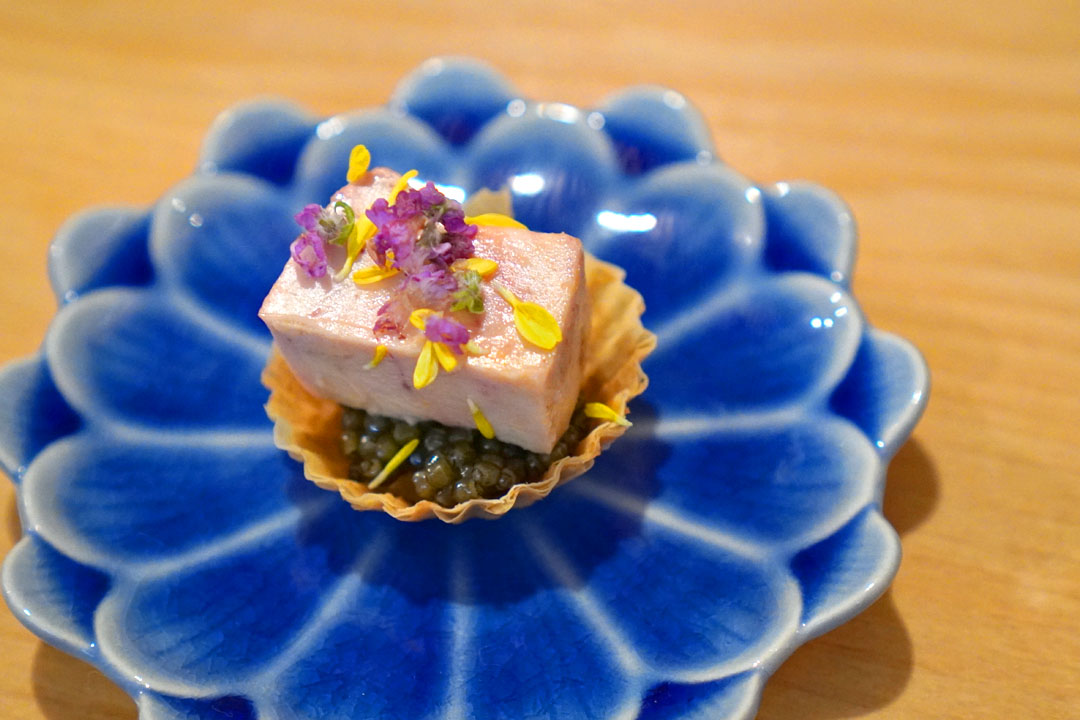
2: Hokkaido Ankimo Tart, Astrea Kaluga Caviar
A decidedly untraditional presentation of sake-poached ankimo effectively paired the monkfish liver's creamy, refined brine with the nutty salinity of caviar and a dusting of shiso blossom and chrysanthemum, all while the tart shell offered up contrast in both taste and texture.
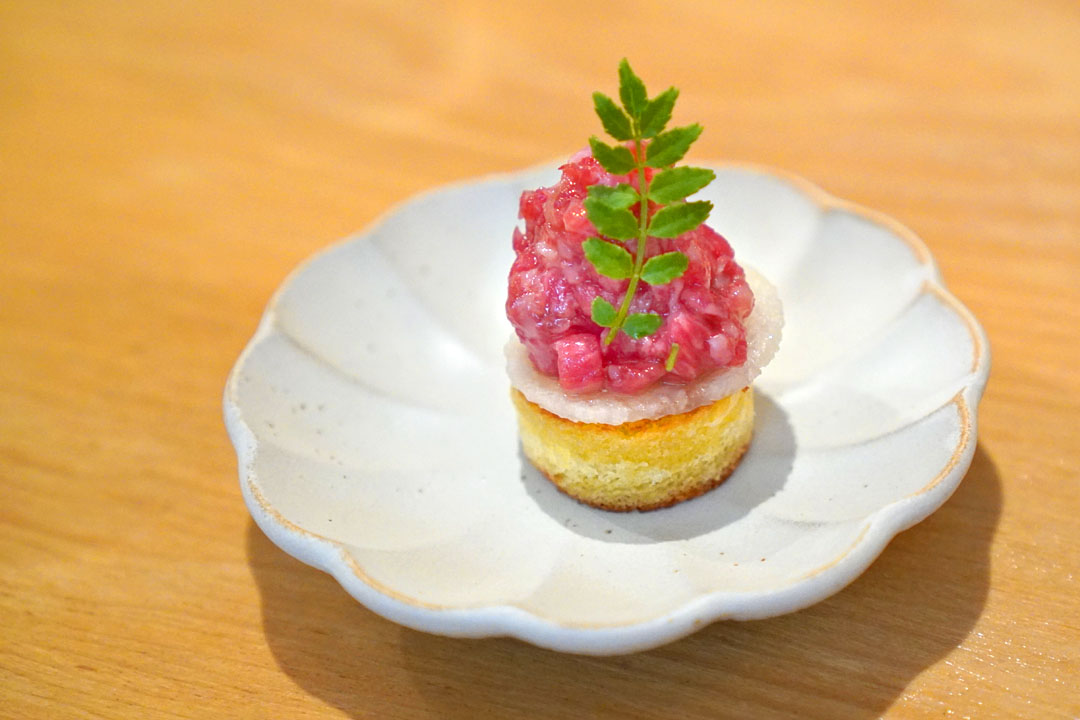
3: Wagyu Yukhoe Toast, Korean Pear, Kinome
Son's take on beef tartare was a winner. I loved the nuttiness imparted by the sesame oil and how that enveloped the meat in such a familiar, satisfying manner. At the same time, the bae gave the bite a juicy sweetness, while the bread served as a moderating force.
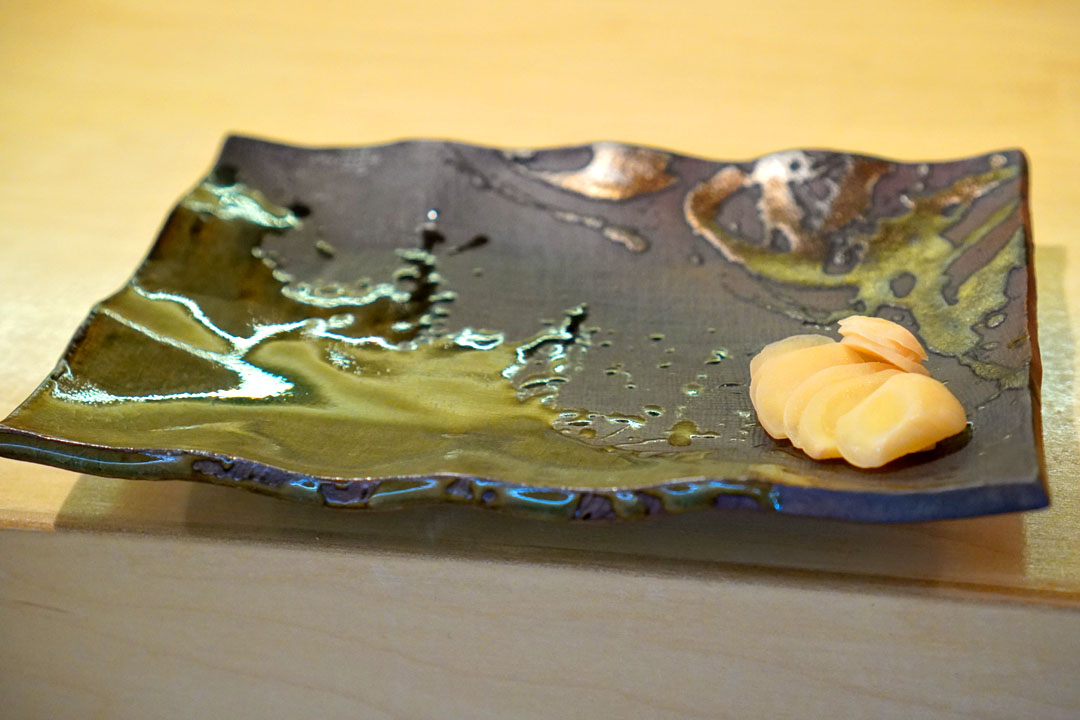
Here we see the somewhat unconventional sushi plate, as well as a portion of the Chef's excellent homemade ginger, which I found milder than most, with a great texture.
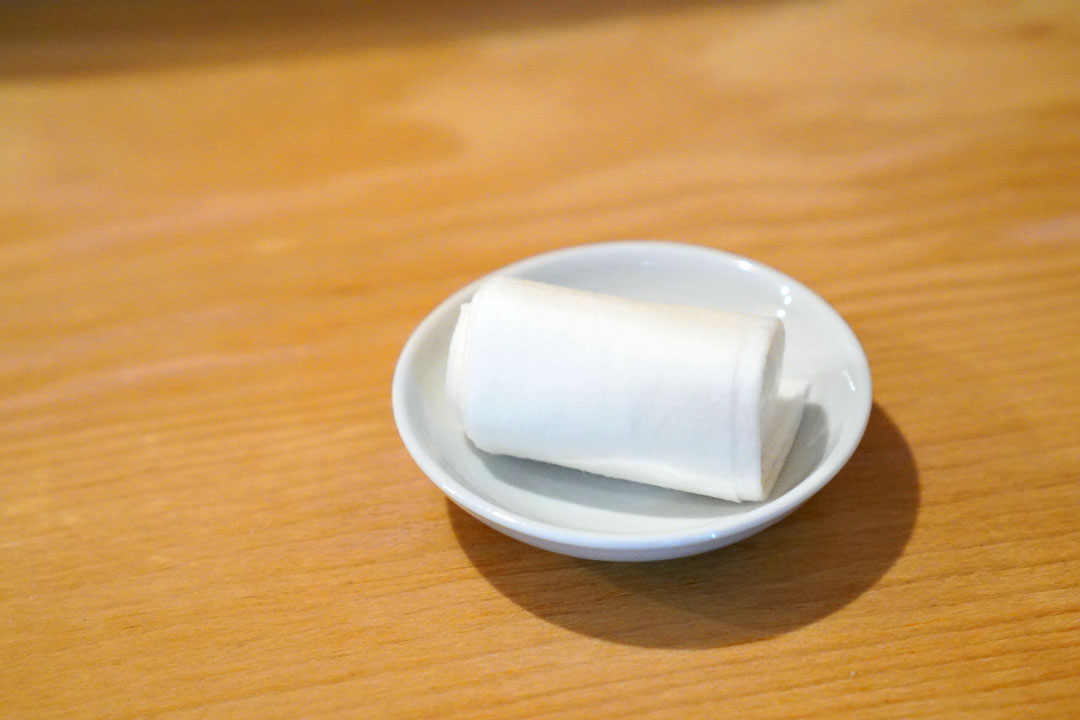
Given that I typically eat sushi sans chopsticks, the arrival of a finger napkin was a welcomed nicety.
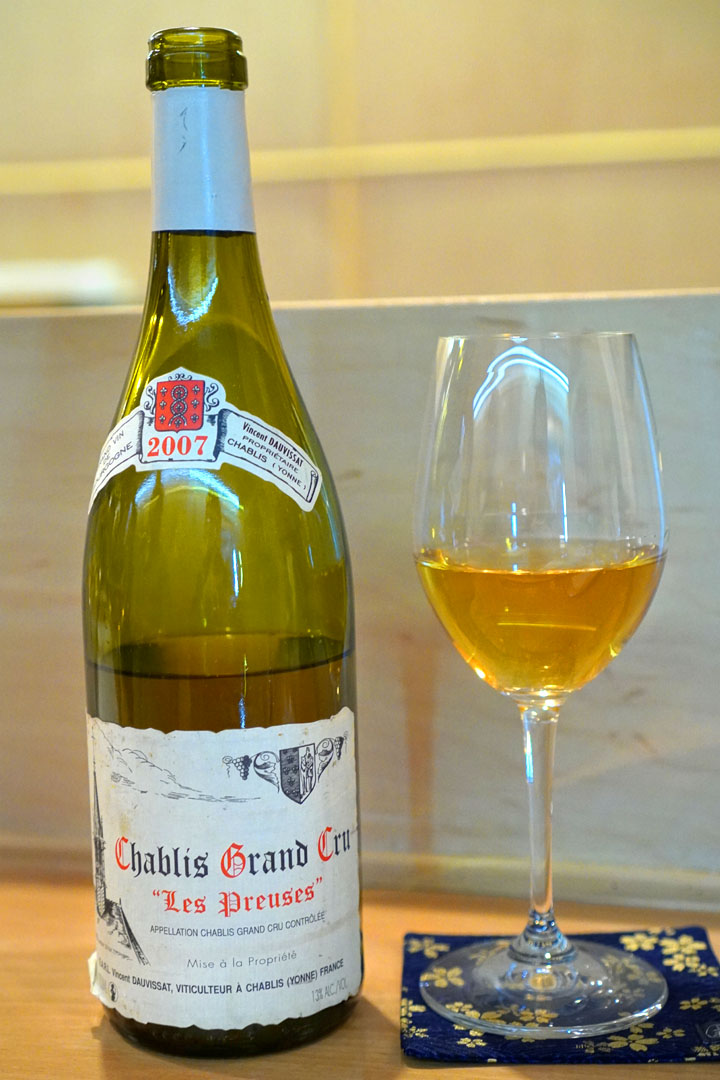
We brought three bottles tonight, and the first was the 2007 Vincent Dauvissat Chablis Grand Cru Les Preuses. Initial aromas here highlighted sour fruits alongside barnyard and caramel. On the palate, I found the wine uncommonly silky, with loads of yellow fruit and a marked grassiness. With more time, the nose actually became more muted, and slightly saline, while taste-wise, I got a lot more saline, but with plenty of mature citrus and hints of pepper.
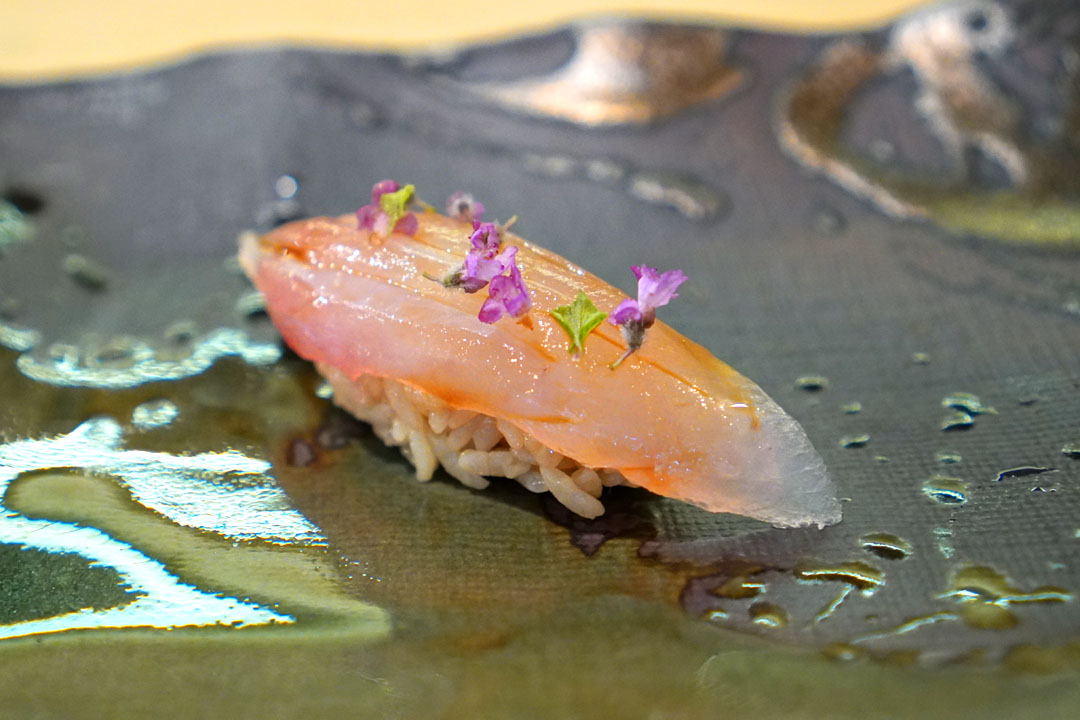
4: Onagadai / Long-Tailed Snapper – Kagoshima
I believe that this was my first time having onaga sushi, and hopefully it's not my last. The snapper was super soft to the bite, and demonstrated a sweetness that linked up superbly with the herby blossoms and the lingering burn of wasabi.
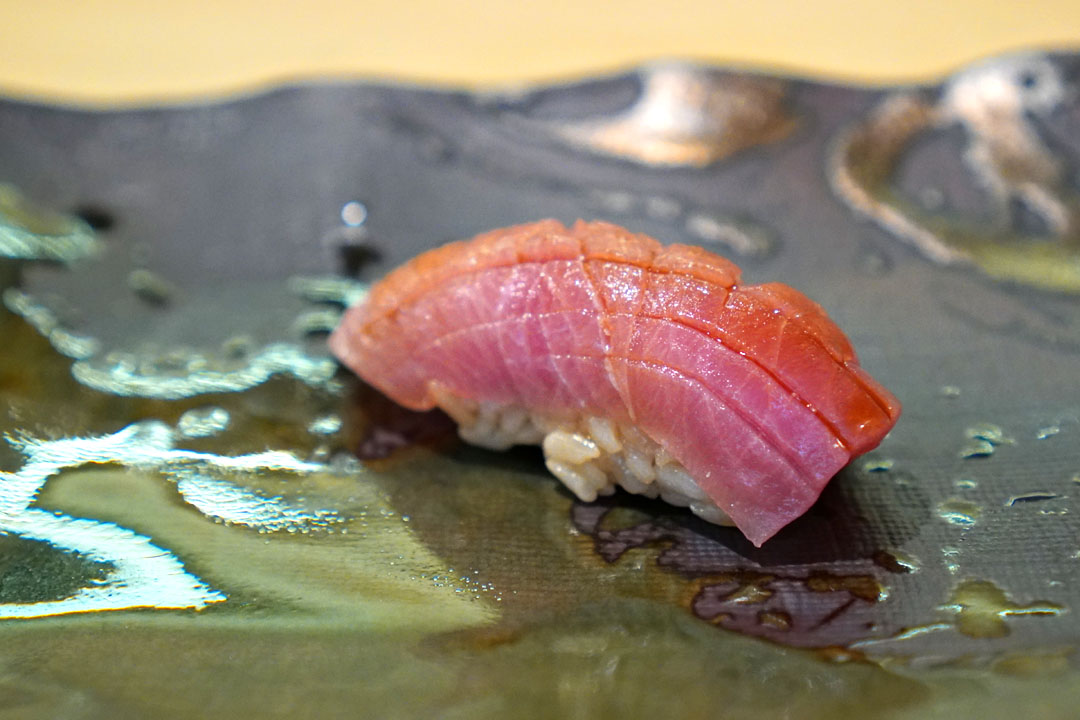
5: Buri / Wild Yellowtail – Toyama
Yellowtail arrived deeply savory, with a great wasabi-fueled heat, while the rice was particularly nutty, and did a great job mixing things up texturally as well.
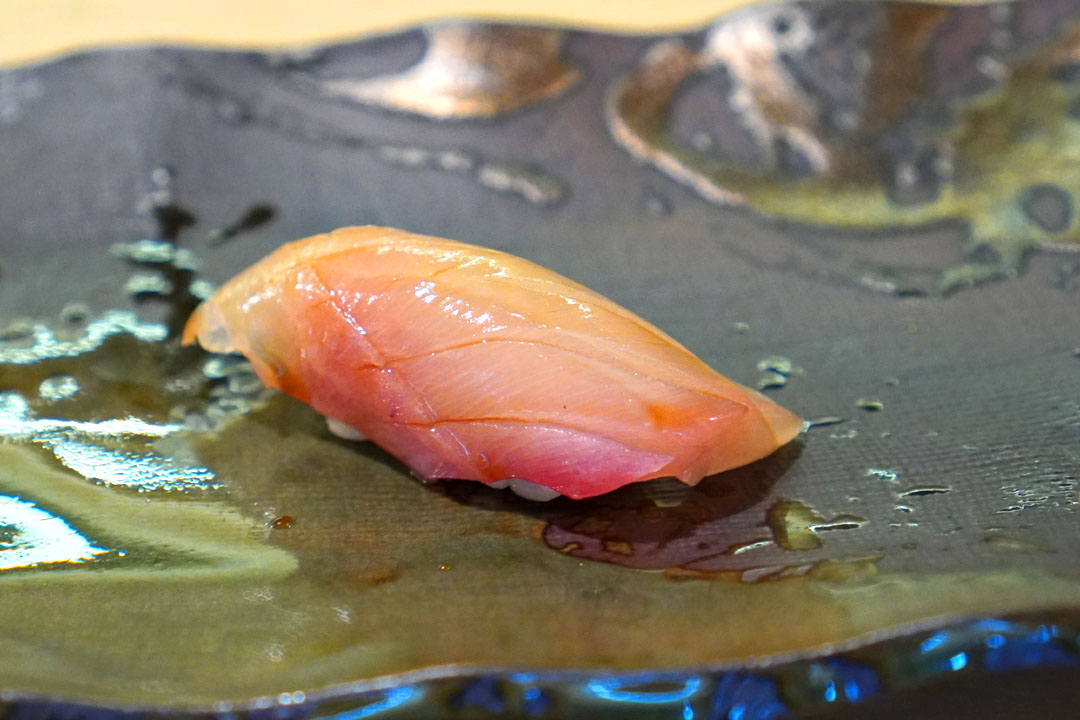
6: Shima Aji / Striped Jack – Kagoshima
The striped jack had this wonderfully "crunchy" consistency, while its considerable umami notes once again juxtaposed swimmingly with Son's seemingly extra flavorful shari.

7: Sawara / King Mackerel – Mie
The Spanish mackerel showcased a fantastic smoke that worked hand-in-hand with the fish's soft, fatty flesh, and I loved how the finish was redolent of both wasabi heat and umami.
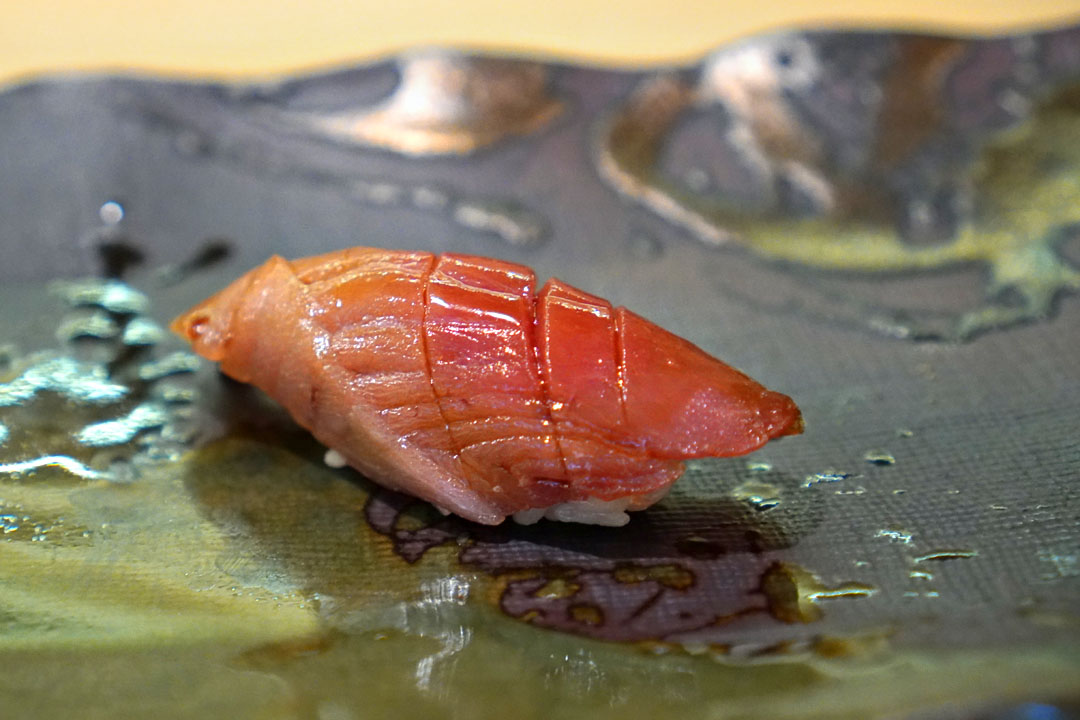
8: Sumagatsuo / Striped Skipjack Tuna – Kagoshima
Not surprisingly, soy-marinated skipjack ate super savory, but its intensity was evened out by the rice, which was much milder in this bite, so I'm assuming that the Chef utilizes a couple different varieties depending on the neta.
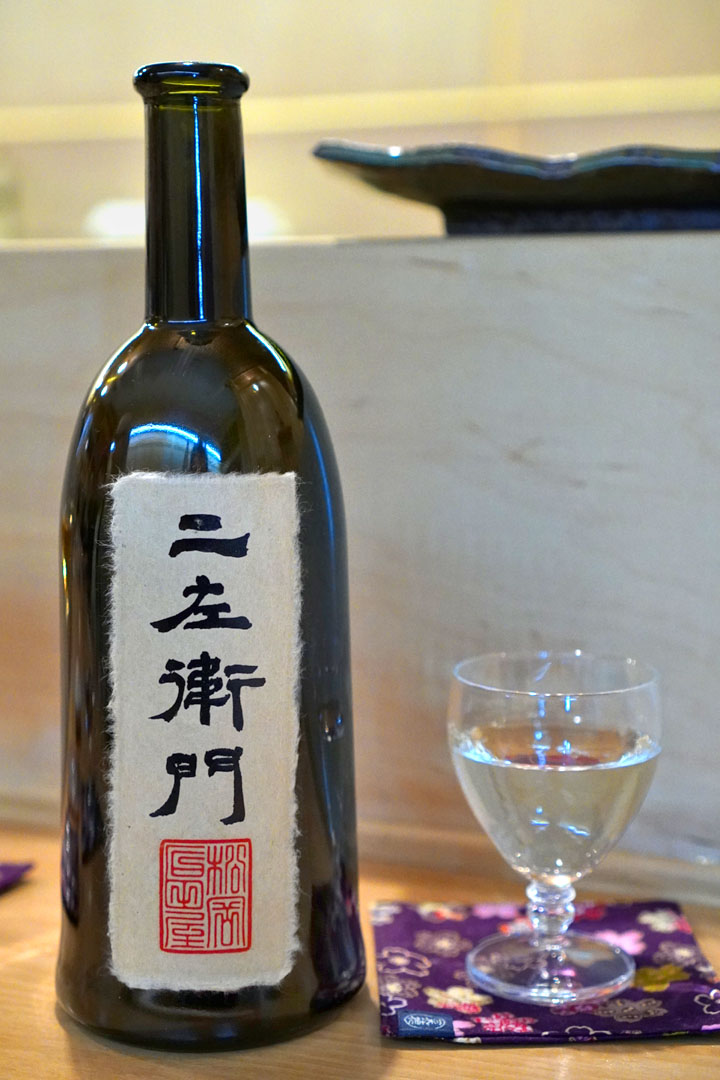
Our second bottle was the 2020 Kokuryu "Nizaemon" Junmai Daiginjo (黒龍 ⼆左衛⾨), a 35% seimai-buai, Yamada Nishiki-based sake. The bouquet here was sugary and inviting, giving up loads of bubblegum and bananas, perked up by a tinge of peppery spice. Taking a sip, I found the nihonshu thick and viscous, its sweet, ricey flavors supported by a rotating cast of tropical fruits.
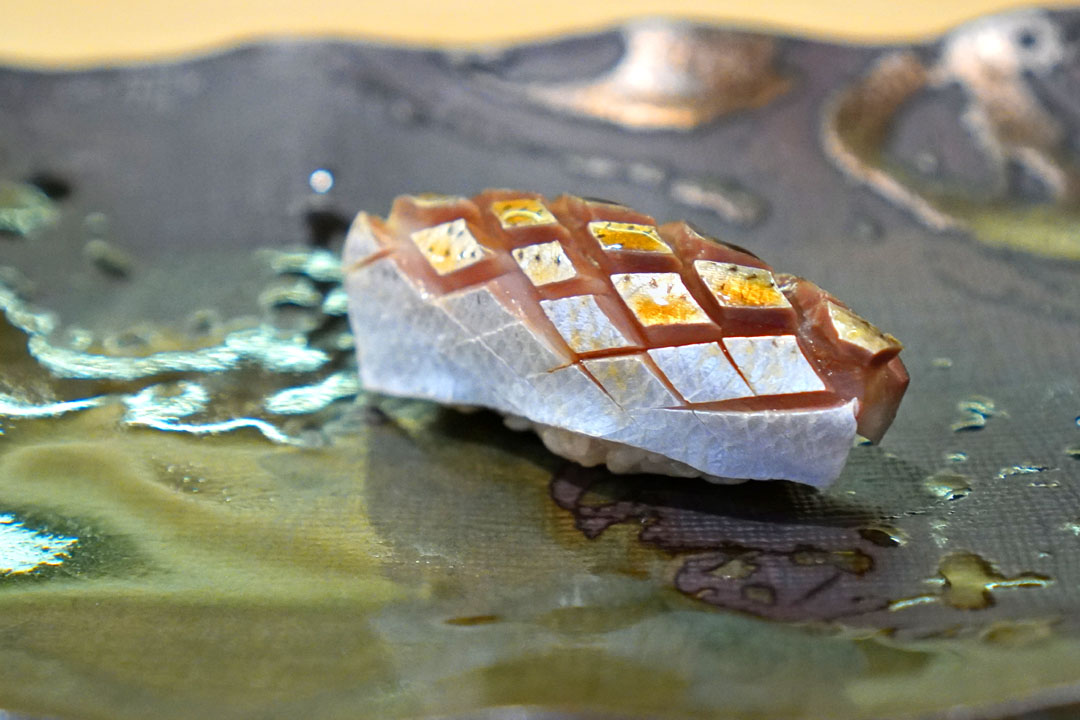
9: Kohada / Gizzard Shad – Kumamoto
Gizzard shad had that oceany taste you expect, but supported by an underlying fruitiness. The fish's strong flavors were balanced out by the very neutral rice utilized, as well as the sting of wasabi.
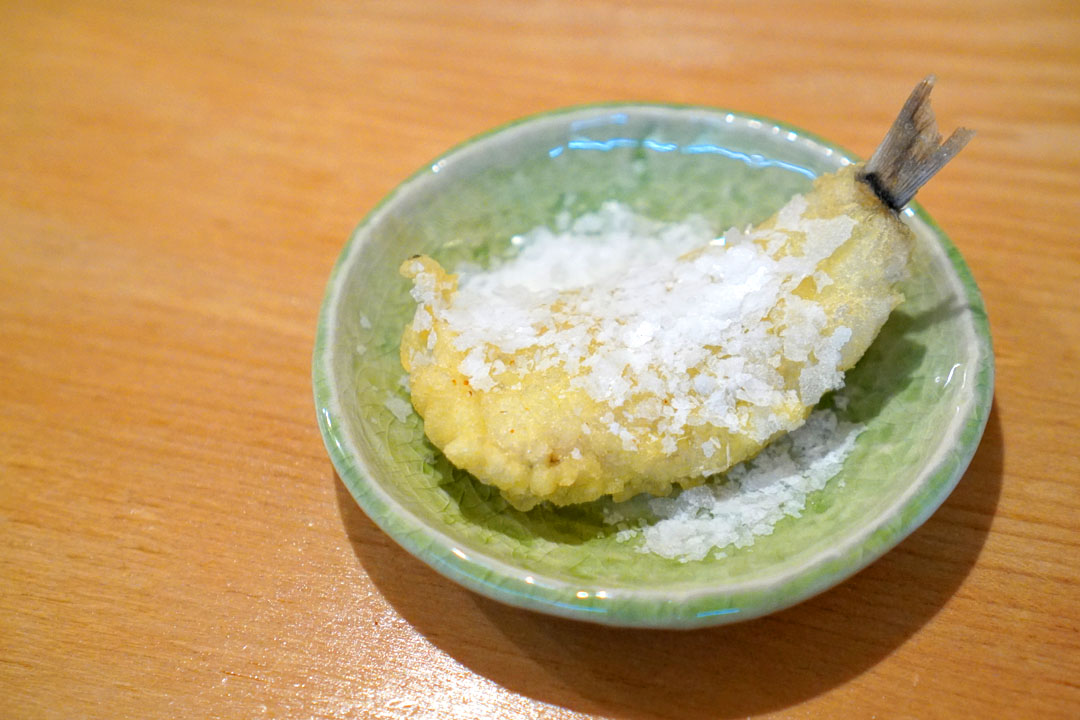
10: Mehikari Tempura / Twinkly Eyes – Shizuoka
Fried greeneye showcased a delectable brininess and a spot-on texture to boot, and matched flawlessly with that flaked salt. Given his apparent facility with tempura, I suggested to the Chef that he should open a tempura-ya next!
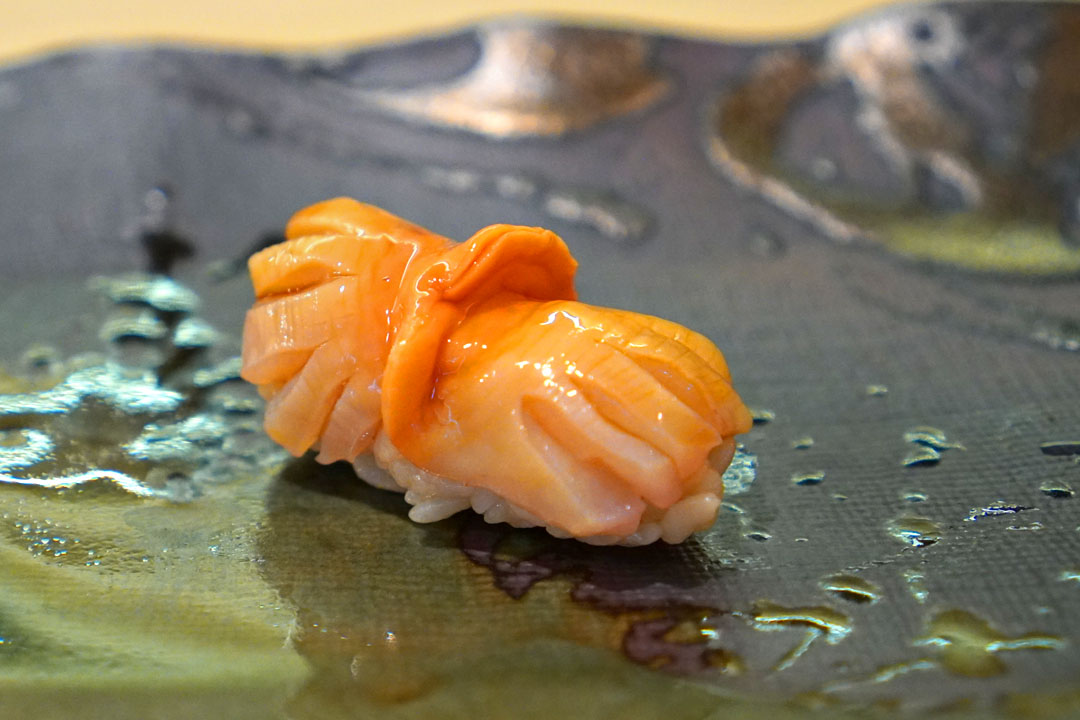
11: Akagai / Ark Shell – Aomori
Ark clam is a relatively rare sight at sushi-ya around Southern California, so I was happy to see it on the menu tonight. I loved its snappy, satisfying consistency, and its unabashedly oceany flavors matched swimmingly with the wasabi and a bit of mintiness, while the assertively-seasoned rice also served as a welcomed counterpoint.
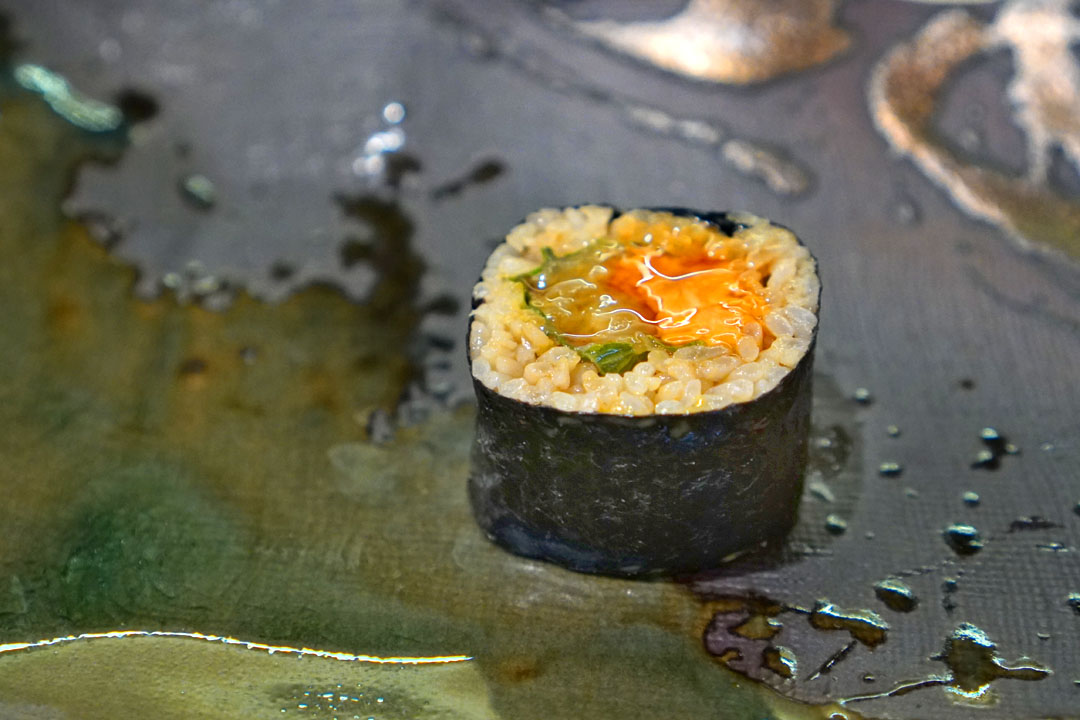
12: Ganjang Gejang Maki / Soy Cured Crab Roll – Korea
Two-week-fermented gejang was combined with Santa Barbara uni, shiso, and perilla oil, making for a creamy, sweet, saline mélange of flavors offset by the refreshing nature of shiso. My quibble here was that I wanted the seaweed to be crisper.
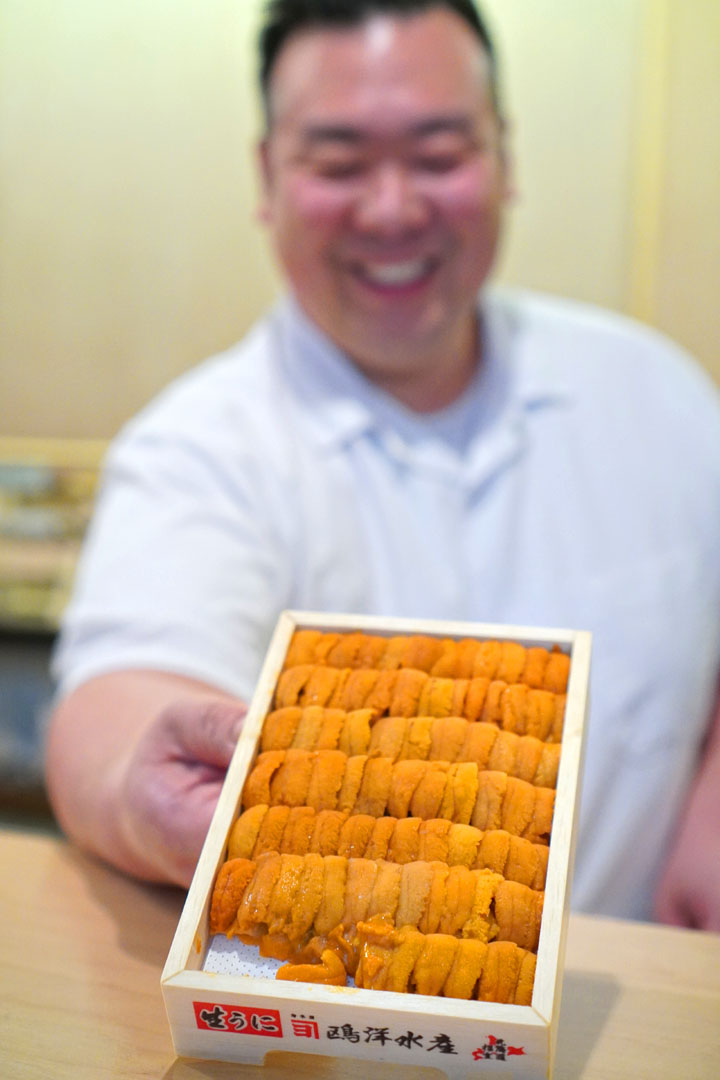
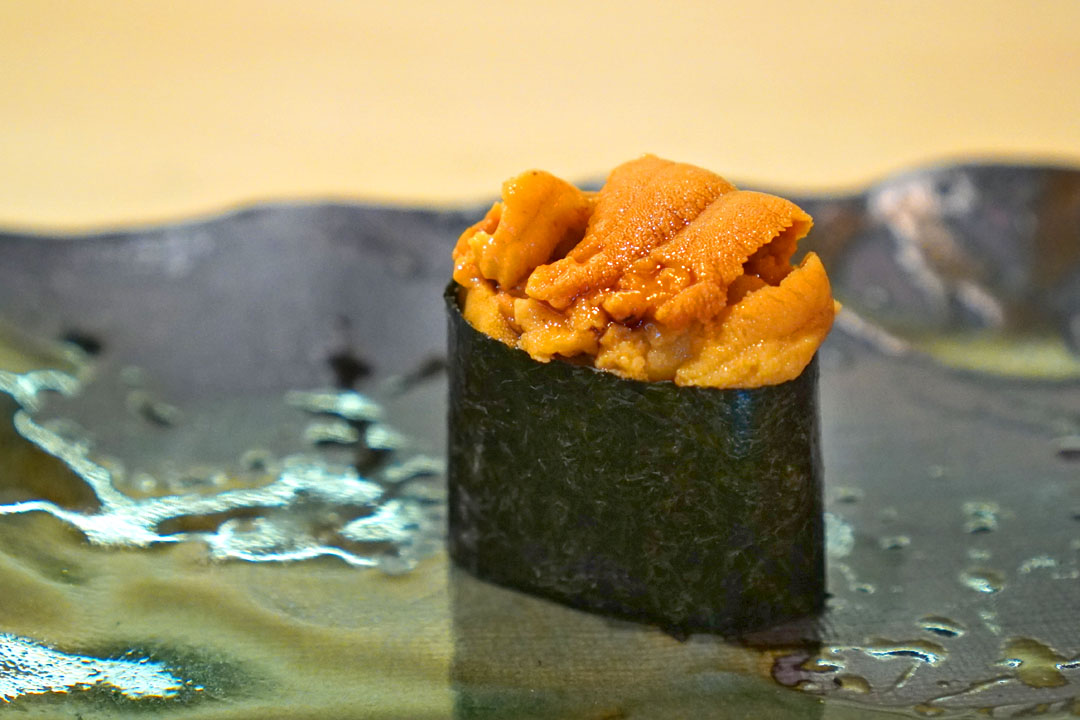
13: Uni / Sea Urchin – Hokkaido
Hokkaido uni ate cool and creamy and utterly classic, with a mineral-driven quality that meshed seamlessly with the seaweed.

Our third and final bottle was the 2020 Kokuryu "Hachijyuhachigo" Daiginjo (黒龍 ⼋⼗⼋号), which also boasted the use of Yamada Nishiki and a 35% rice polishing ratio. Again, the sake smelled quite distinctly of fresh bananas, but with traces of herbs and spices. It was super smooth over the tongue, with its ricey, astringent, savory nuances joined by more spices as well as florals.
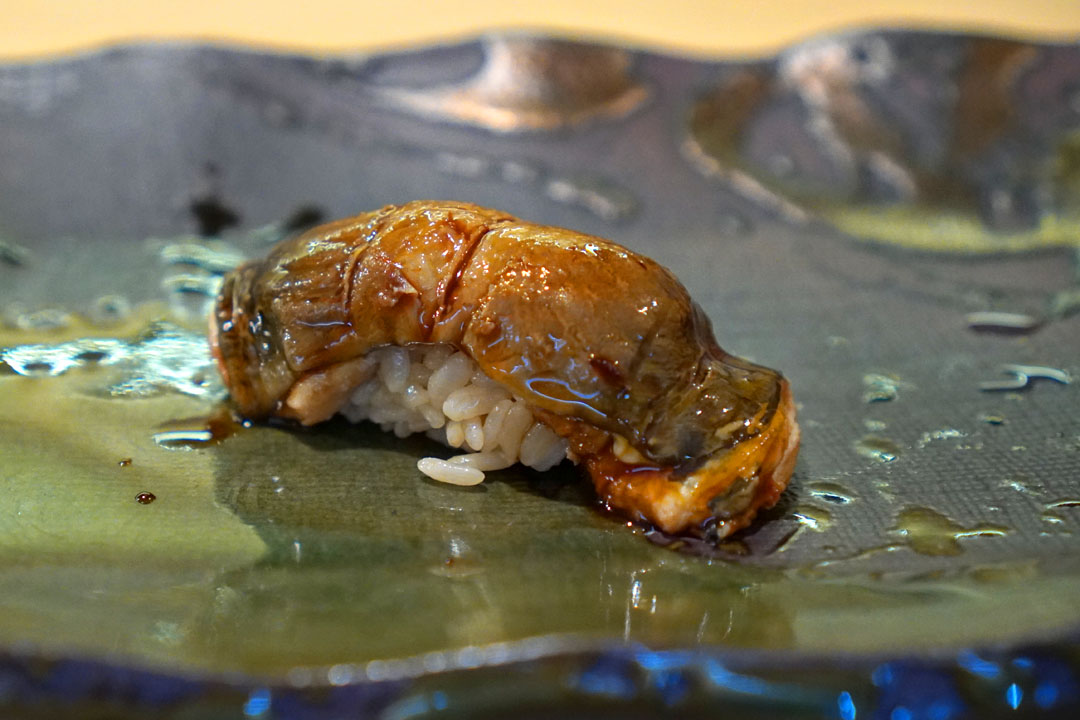
14: Anago / Sea Eel – Nagasaki
Conger eel was melt-in-your-mouth tender, and just might've been the softest example I've ever had. It was also sweeter than usual, which worked with the fish's palpable smokiness.

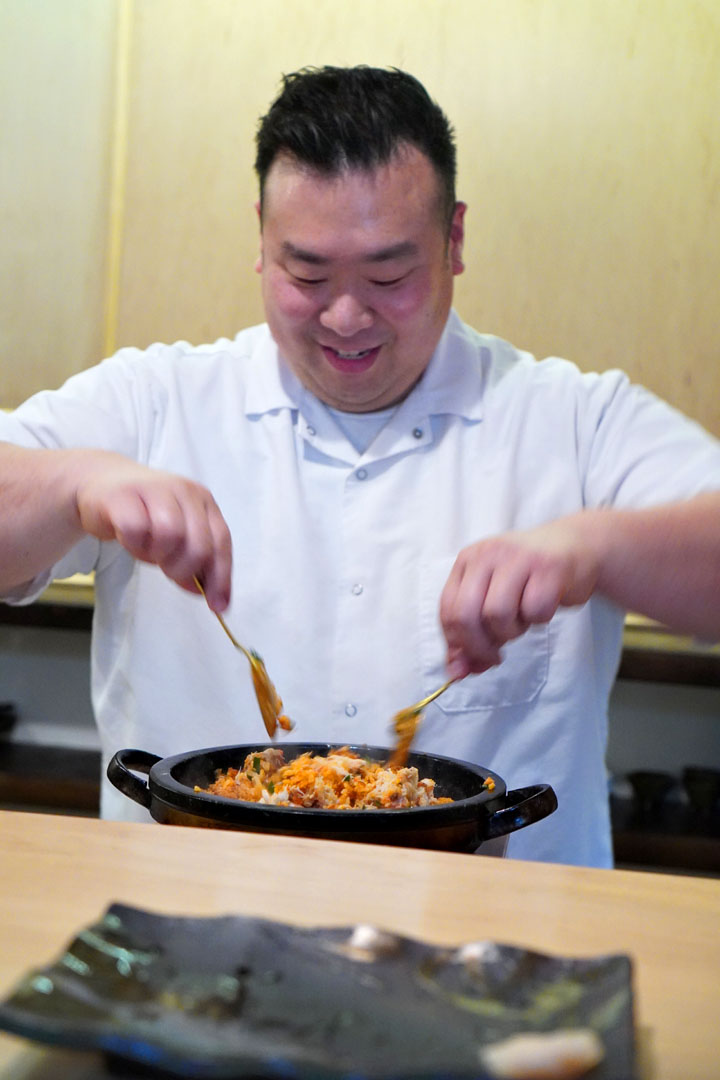
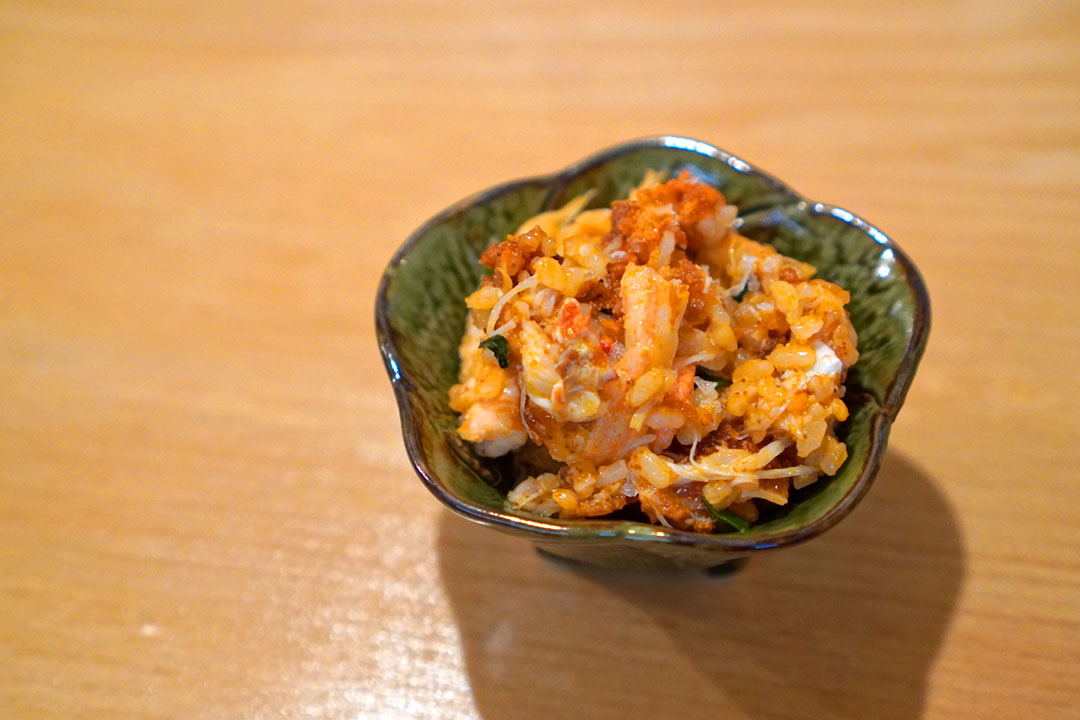
15: Dolsot Sekogani / Female Snow Crab – Fukui
The seikogani, served with its roe and kanimiso, was definitely a favorite, and easily a contender for the best thing I've eaten all year. I just got loads of concentration, depth, brine, umami, and sheer crab-y goodness, and reveled in all that nutty, crispy, toasty nurungji. Everything just came together flawlessly.
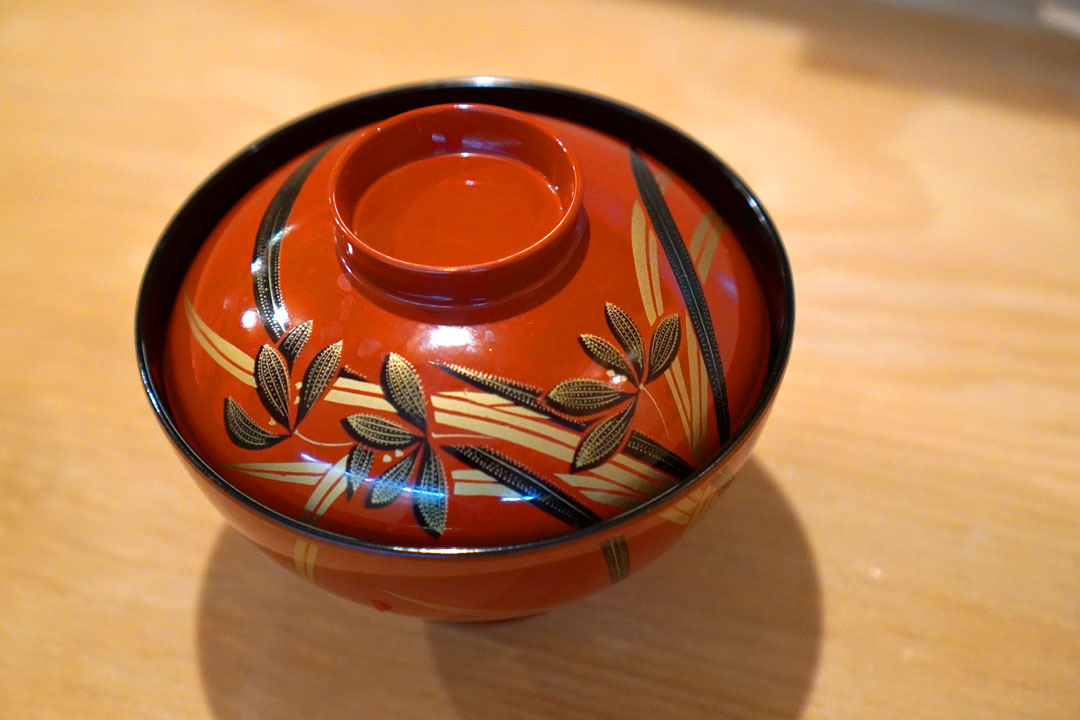
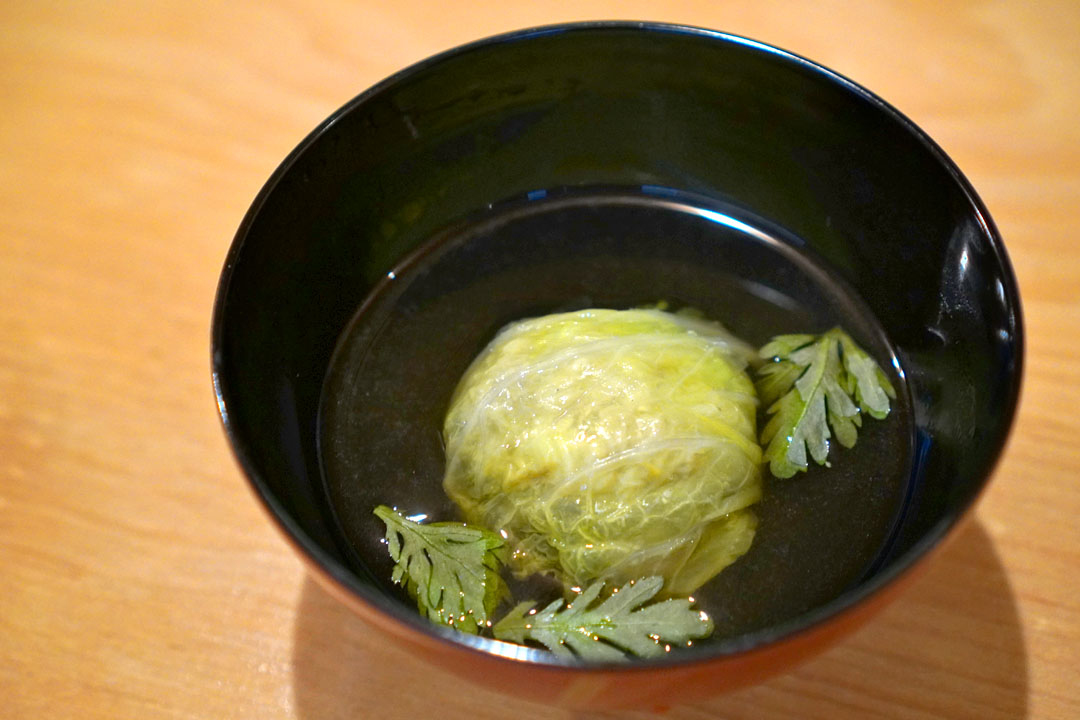
16: Dungeness Crab Soup, Shingiku, Yuzu – Oregon
Cabbage-wrapped Dungeness displayed some wonderfully homey, yet delicate flavors, boosted by a mushroom dashi, while the shungiku brightened things up.
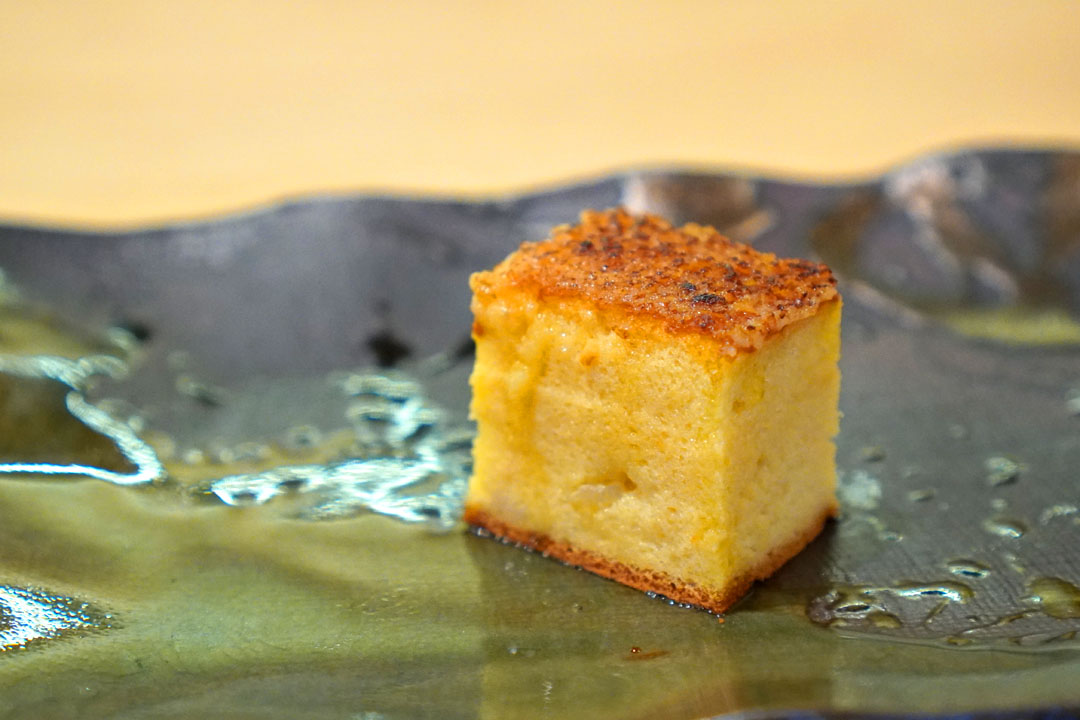
17: Miso Butter Atsuyaki Tamago / Miso Butter Omelet
Son's tamagoyaki incorporates miso, butter, scallop, and shrimp, and was quite a bit more assertive (and tastier) than most. Think sweet and saline, and quite "juicy."
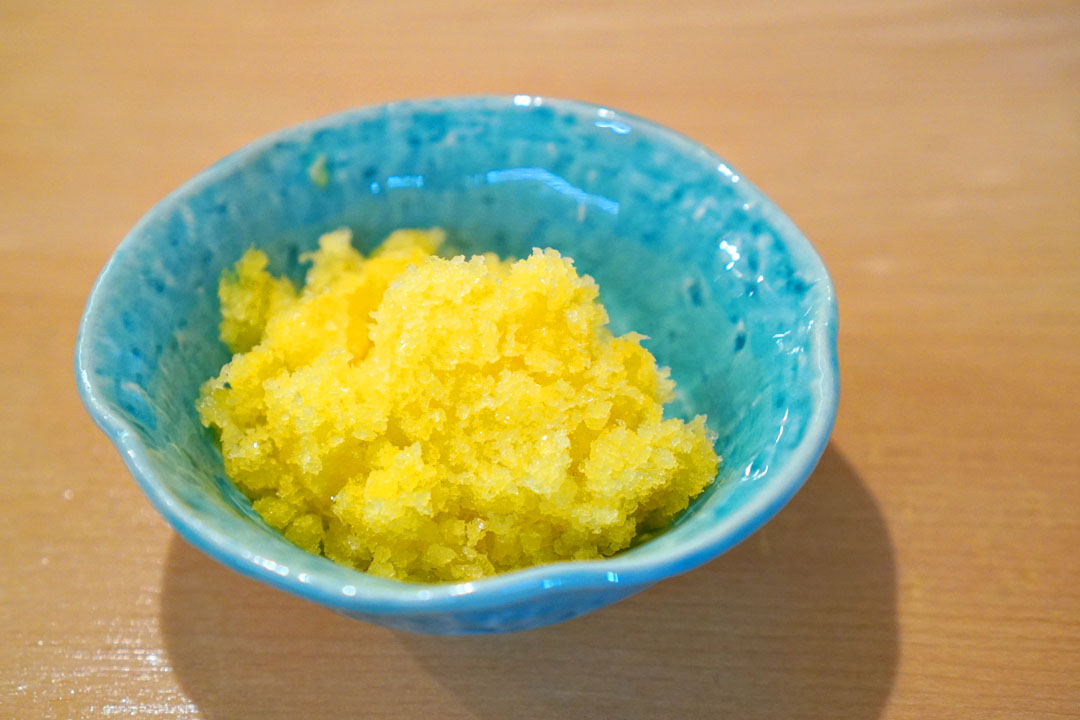
18: Yuzu Panna Cotta, Mandarin Ice – Torrance
A zippy citrus granita was set against yuzu pudding, making for a palate-cleansing sort of dessert that left me refreshed.
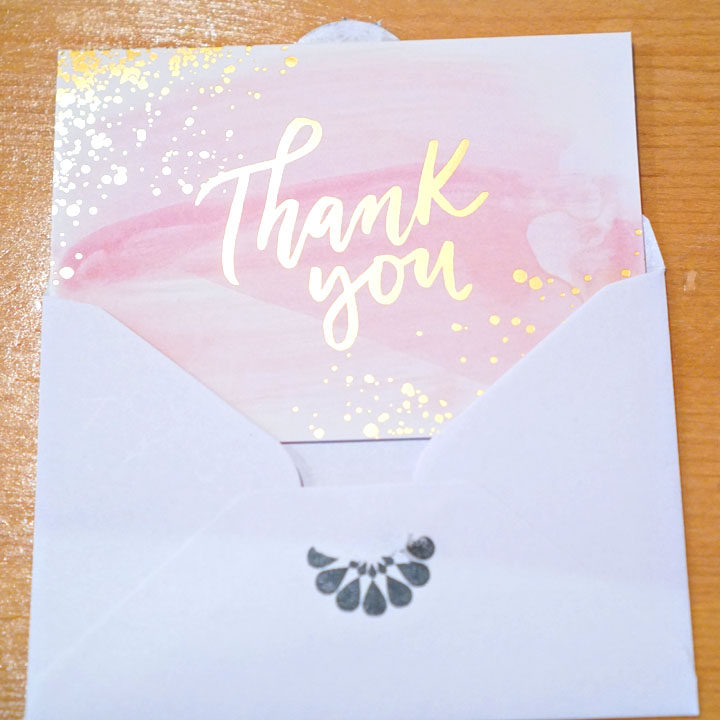

We were given a thank you card at the end of the meal, which was a nice detail. If you're curious about Janet and Annie, they're the Chef's wife and sister, respectively, who help with running the restaurant.
Sushi Sonagi made a strong case for itself tonight, and in fact, I'd deem it one of my top meals in LA this year. Son clearly respects Japanese tradition, but at the same time, he's clearly not bound by it. I really enjoyed the thoughtful Korean touches that he incorporated into the meal, and also appreciated the Chef's affability and the family-run nature of the restaurant. It all came together for an omakase experience unlike any other in the region, and I have to conclude that Sonagi is a worthy addition to Los Angeles' sushi pantheon.

We weren't quite stuffed after dinner, so for some final bites, we made our way to Volcano Burgers in Los Alamitos, an old haunt of mine from my teenage years.
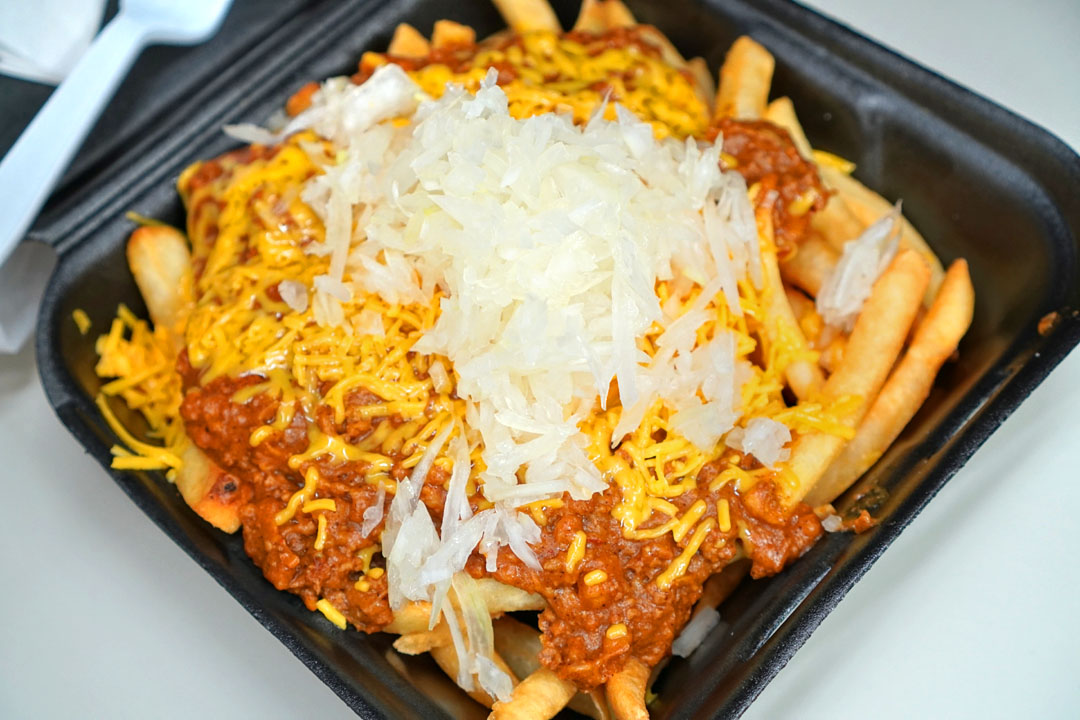
Chili Cheese Fries + Onions [$7.99]
The dish to get is the chili fries, which I first tried in 1995 and which I still order every single time I come here. The fries they use are the perfect type for this application, and I can't fault the chili either, while the zestiness of those onions is absolutely crucial, really brightening things up. I have yet to find a better chilli fries.